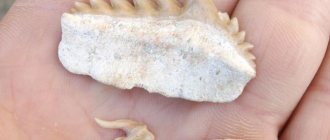Nowadays on the Internet you can find any information or video in a minute, but before I learned all the interesting facts from educational programs on TV. I remember there was a channel where they told a lot of interesting things about the animal world for days on end. I really remember the creepy footage from sharks, their huge jaws with hundreds of teeth. When we went to the sea with my parents as a child, I was even a little afraid to go into the water, it seemed to me that a shark’s fin was about to appear. Are sharks really as dangerous as we used to think?
What does a shark look like - general characteristics
Sharks, whose diversity on Earth exceeds 500 species, belong to the cartilaginous elasmobranch class of vertebrate fish.
In no case should they be considered mammals, like dolphins or whales; this predator is a fish.
Most species of this predatory fish are characterized by general external characteristics:
- an oblong body, similar to a torpedo, tapering towards the mouth (rostrum) and towards the tail, which ends with a heterocercal fin;
- lateral lamellar gills resembling slits, with 5 to 7 slits on each side;
- huge black-matte eyes, behind which there are openings entering the throat, called splashes.
Sea hunters can boast of a variety of skin colors (white, gray, blue, spotted, striped), depending on the species to which they belong.
External and internal structure of a shark
Most of them have a streamlined, rounded body shape, with an elongated and narrowed front part and head - all this significantly helps to reach speeds of up to 80 km/h.
However, there are external differences among sharks
, such as:
- A hammerhead fish whose head is precisely shaped like a compressed hammer. On the T-shaped head, next to the nostrils on the sides, there are eyes that have binocular vision.
- “Sea angels” - due to their flat body, they look like stingrays and live on the bottom.
- Carpet sharks, like angelfish, are adapted to live on the bottom. On the sides of the head there are outgrowths that resemble fringes and help to camouflage well in algae thickets.
They differ from each other in size: some reach 20 meters in length, while others, the smallest, have a body length of only 17 centimeters.
Shark scales
In phylogenetics, the shark is considered the most ancient representative among fish due to the structure of its skin. Consisting of durable diamond-shaped plates with spikes that fit tightly together, the skin appears very smooth.
Such a durable placoid scaly covering of the skin protects it well from attacks by other animals and from parasites, but still fetters movement, like chain mail.
Throughout its long evolutionary period, the skeleton has not undergone any changes, but has completely lost bones, which have replaced cartilaginous connective tissue.
Modern sharks have a skeleton and skull made of cartilaginous tissue.
Its skeletal axis, like everyone else’s, is the spine, consisting of cartilaginous amphicoelous vertebrae. The shark skull is divided into two sections: the oral skeleton with gill apparatus and the cranium. Its body is equipped with separate fins located in the tail and back areas, and paired fins in the chest and abdominal areas.
The muscular system of these predators is responsible for the continuous functioning of the heart, for the arteries and internal organs, and for movement itself, whose muscular functionality is divided into bundles of individual muscles.
Since there is no swim bladder in a shark carcass, the fins, spine and large liver are responsible for its buoyancy.
Links[edit]
- "Shark Teeth".
- "Fossil Folklore".
- "Shark Rescuers:: Shark Teeth".
- ^ abc "What do sharks eat - diet for sharks". Types of sharks
. - ^ abcde Zen Cart® Team; and others. "On Fossil Shark Teeth".
- "6 plus inch megalodon shark teeth".
- ^ ab "FLMNH Ichthyology Division: Fossil Sharks".
- ^ abc Hennemann, Ralph M. (2001). Sharks and Rays: A Guide to the World's Elasmobranchs
. IKAN-Unterwasserarchiv. pp. 266–269. ISBN 978-3-925919-33-6. OCLC 223251653. - ^ abcd "Sink Your Teeth into It: 20 Facts About Shark Teeth". Deckchair Scientist
. - "Georgia State Fossil - Shark Tooth".
- Case, Gerard (1967). "Fossil sharks and fish remains of North America". clause 2.
- Heemstra, PC; Hiemstra, E. (2004). Coastal fishes of southern Africa. NISC/SAIAB. P. 47. ISBN 1-920033-01-7.
- Naylor, Gavin JP; Marcus, Leslie Floyd (1994). "Identification of individual shark teeth from the genus Carcharhinus by species." American Novitates Museum
. hdl: 2246/4942. ProQuest 51542224. - Ahonen, H.; Stowe, A. J. (29 July 2008). "Shark jaws and teeth: an unexplored resource for population genetic research." Journal of Fish Biology
.
73
(2):450–455. DOI: 10.1111/j.1095-8649.2008.01896.x. - Chen, Chunlin; Wang, Zhongchang; Saito, Mitsuhiro; Tohei, Tetsuya; Takano, Yoshiro; Ikuhara, Yuichi (February 3, 2014). "Fluorine in Shark Teeth: Its Direct Atomic Resolution Imaging and Enhancement Function." Angewandte Chemie
.
126
(6):1569–1573. DOI: 10.1002/ange.201307689. - Becker, Martin A.; Seidemann, David E.; Chamberlain, John A.; Buhl, Dieter; Slattery, William (July 2008). "Strontium isotope signatures in emeloid and dentin of Upper Cretaceous shark teeth from western Alabama: paleoenvironmental and geochronological implications." Paleogeography, paleoclimatology, paleoecology
.
264
(1–2): 188–194. DOI: 10.1016/j.palaeo.2008.04.006. - Whitenack, Lisa (November 7, 2008). "Biomechanics and evolution of shark teeth". Master's theses and dissertations
. ProQuest 304460308. - “Shark teeth are falling! - Dharma Beach is a slacker." Homeless man on Dharma beach
. Archived from the original on 2014-11-13. - Jump up
↑ Haven, Kendall (1997). The 100 Greatest Scientific Discoveries of All Time. Libraries without limits. pp. 25 -26. ISBN 1-59158-265-2. - Bruner, John (1997). "Megatus Shark". FLMNH. Archived from the original on 2007-12-28. Retrieved January 16, 2008.
- "Treasures of Hawaii: Shark Tooth Weapons". bishopmuseum.org. Archived from the original on 2008-12-04. Retrieved November 27, 2008.
- Taylor, Leighton R. (1993). Sharks of Hawaii: Their Biology and Cultural Significance. University of Hawaii Press. paragraph 28. ISBN 978-0-8248-1562-2.
- ↑
Anthony Meyer (1995)
Oceanic Art,
v. 2, p. 579. - Métraux, Alfred (1946) Handbook of the Indians of South America,
vol. 1, p. 522, "Guaitaca" - Greg Perino, c. 1950, Cahokia Comes to Life,
pp. 66-67. - Métraux Alfred (1940), "ethnology of Easter Island". Bulletin of the Bernice P. Bishop Museum
(Honolulu: Bernice P. Bishop Museum Press) 160: 404
How many teeth does a shark have
The shark's jaw is located extremely inconveniently for fish. In order to grab onto the victim, she has to bend to the side or even roll over onto her back, but this does not reassure her victim at all.
The jaw, with numerous rows of sharp and jagged teeth at the edges, easily bites into the flesh, giving no chance of escape.
The number of teeth and rows varies depending on the species of fish. In some, the number of rows reaches 50, and the total number of teeth reaches 1.5 thousand, like a reef shark. The largemouth shark has up to 10 thousand teeth per 22 rows.
Lost teeth are not a big problem for this predator, since they are replaced by teeth from other rows, representing a kind of conveyor belt.
Human use of tools[edit]
Hilbertian weapon with shark teeth.
In Oceania and the Americas, shark teeth were commonly used to make tools, especially weapons such as clubs and daggers, but also as wood carving blades and cooking tools. For example, various shark-tooth weapons were used by the native Hawaiians (see example here [21]), who called them leiomano. [22] Some types were reserved for the royal family. [23] Guaitaca (Weittaka) offshore Brazil arrowhead with shark teeth. [24] Remains of weapons with sharp shark teeth, as well as flint replicas of shark teeth, were found in the Cahokia Mounds in the upper Mississippi River Valley, more than 1,000 km (620 mi) from the ocean. [25] Rongorongo tablets from Easter Island are reported to have been shaped first and then inscribed using chopped shark tooth. [26]
Where are sharks found?
Numerous species of predatory fish live in all oceans and seas, but not all of them are so dangerous to humans.
Shark habitats
For example, the bearded shark is found in the Indian Ocean, the whale shark can be found throughout the World Ocean, the giant shark prefers seas with temperate or cool waters.
But some of the dangerous predators are often observed in crowded places: off the sandy beaches of Africa, Florida, California, off the Hawaiian Islands, resorts in Egypt, Southern Primorye (Russia), off the coast of Australia.
There are also freshwater predators that live in the lake water of Nicaragua, and are also capable of living in both salty and fresh waters (common gray and blunt-nosed sharks).
Respiratory system
Like other fish, sharks extract oxygen from water passing through their gills. A whale shark's gill slits can widen as it pushes water out of its pharyngeal cavity. Most sharks have an additional breathing hole behind their eyes called a spiracle. Bottom sharks have an outlet that allows them to breathe without opening their mouth and collecting dirt.
Sharks use two mechanisms to breathe:
- Buccal pumping - it actively draws in water using the cheek muscles, and when moving forward, pushes the water out through the gills.
- Ram ventilation - the shark swims forward, pushing water into the mouth and over the gills.
Buccal expression is more energy intensive and is usually used by sharks that have a sedentary lifestyle, while the second method is used by more active sharks. Depending on the situation, sharks can use both methods, but some species have lost this ability. For example, a great white shark can suffocate if it stops moving.
What do sharks eat?
Some of the representatives of sea hunters feed on plankton and small inhabitants of the bottom, but, basically, this is an omnivorous predator that attacks whales, dolphins, fur seals, humans and its own relatives, and does not disdain cans, iron, plastic and other garbage.
The lack of disgust for a variety of food, even dead ones, allowed this predator to survive centuries of competition with other representatives of the aquatic world.
Shark breeding
Sharks, like cartilaginous fish, have a common process of internal fertilization. The developed fetus in the uterus is independent after birth and is adapted to fight for its survival.
In cubs, the entire body with the digestive system, musculoskeletal system and sensory organs is fully developed, which contributes to rapid growth.
These predators are divided into viviparous, ovoviviparous, and oviparous.
Viviparous individuals give birth to from 20 to 40 cubs, which, while still in the womb, turn out to be dangerous predators, eating their own, which is why only one can be born.
Shark egg capsules
Ovoviviparous and oviparous animals give birth from 1 to 12 individuals, and the polar shark alone can produce up to 500 pups.
The exact period of gestation is not known; approximately 11 months to 2 years have been recorded.
Discovery history[edit]
Scapanorhynchus texanus
, Menuha Formation (Upper Cretaceous), southern Palestine.
Shark tooth
The oldest known records of fossilized shark teeth are those of Pliny the Elder, who believed that these triangular objects fell from the sky during lunar eclipses. [18]
According to Renaissance accounts, large triangular fossilized teeth, often found in rock formations, were thought to be the fossilized tongues of dragons and snakes, and were therefore called "tongue stones" or "glossopetras". Glossopetrae
usually considered a cure for various poisons and toxins;
they were used in the treatment of snake bites. Because of this ingrained belief, many nobles and royals wore these "tongue stones" as pendants or kept them in their pockets as good luck charms. [ citation needed
]
This interpretation was corrected in 1611 by the Italian naturalist Fabio Colonna, who recognized them as the teeth of an ancient shark, and in 1667 by the Danish naturalist Nicholas Steno, who discussed their composition and created the famous image of a shark's head with such teeth. [19] He mentioned his findings in the book Dissected Shark Head
, which also contained an illustration of a
C. megalodon
, which was previously thought to be a tongue stone. [20]
Types of sharks - photos and brief description of the species
Since there are over 500 species of sharks, differing from each other in their modes of birth, habitat, food preferences, behavior and external differences, each of them has a specific class and name.
Some of these representatives prefer expanses of water and the depths of the sea, while others like to scurry along the coast. Some of them may be indifferent to a person unless he himself shows disrespect for the predator, while others purposefully seek a meeting with him.
Let's look at some of the elasmobranch fishes.
White shark
- the largest and most terrible representative of predatory fish. It ranks first in danger and is considered a human killer.
It lives in all oceans and swims along the coast, where it often attacks people, mistaking them for seals. However, most people die from blood loss and injuries, since she, having felt the bones, instead of the tender meat of the seal, releases her victim.
With a length of 6 meters, its weight reaches 2300 kg.
bearded shark
- being a lover of coral reefs and shallow depths, she is a good master of camouflage, in which she is helped by a flattened body, gray-brown or yellow color with large spots, and hanging fringed processes. The fish can reach 3.5 meters in length.
Hammerhead shark
— likes to circle near the shores of tropical waters. The six-meter aggressive predator often gathers in flocks. It is very dangerous for humans due to its attack.
Angelfish
— the bottom of the Atlantic and Pacific oceans is the habitat of this unusual fish, which received its beautiful name due to its flattened body, similar to the body of a stingray, and wing-shaped fins.
This shark feeds on mollusks and crabs, reacting with lightning speed to its prey and easily grinding its shells.
Whale shark
- the largest existing fish today. Its size reaches 20 meters, this beauty can weigh up to 12 tons.
Its main food source is plankton. And when meeting a person, she prefers to modestly pass by, ignoring him.
Reef shark
- small and graceful, with a thin body and flat head, reaches only 20 kg.
She treats people with great curiosity, and if she is not offended, she is quite peaceful.
Fins
A shark's fins allow it to quickly rise and fall to different layers of water. Most sharks have eight fins:
- a pair of pectoral fins;
- pair of ventral fins;
- two dorsal fins;
- anal fin;
- caudal fin.
The shark's pectoral fins are very rigid, due to which it has excellent maneuverability.
Representatives of the order Hexanchiformes have only one dorsal fin. The anal fin is absent in the orders Squaliformes, Squatiniformes and Pristiophoriformes.
Interesting facts about sharks
The eyes of a sea predator are very similar to humans; they also distinguish colors, but have a greater advantage: in opaque water they can see at a distance of up to 15 meters; exceeds cat and human vision several times; captures a change of 45 frames per second, while a person distinguishes 25 frames.
Every year there are reports of attacks by sea hunters on passing ships; up to 10 cases have been recorded.
These hunters are very curious, so they often try inedible objects. When opening the abdominal cavity, various objects are repeatedly discovered.
The white shark lives up to 30 years, and only in the seventh year of its life does it attack people, until that time feeding only on fish. This predator can survive without food for several months. But in captivity, she voluntarily refuses food and dies on the 10th day.
Before attacking, the sea hunter draws circles around his potential victim to understand its weakness.
Is it possible to make an amulet yourself?
To save money, you can simply purchase the most important thing - a fang, and then make an amulet from a shark tooth yourself. Such a talisman, by the way, will be much stronger than one bought in a souvenir shop. Firstly, you will immediately tune it to your energy. Secondly, you can bring the craft into full compliance with the tradition that you adhere to.
There is nothing complicated in making such a talisman. We have already talked about the simplest option - the amulet can be worn around the neck or in a pocket. A small tooth can be hung from a bracelet or worn as an earring.
You can also wear it on a bunch of keys, like a keychain, or hang it in your car. Show your imagination and create a talisman that you would like to wear yourself. If desired, you can coat the tooth with varnish, decorate it with stones, and insert it into a frame. A jeweler can add silver or gold to the amulet and thread a chain into it.











